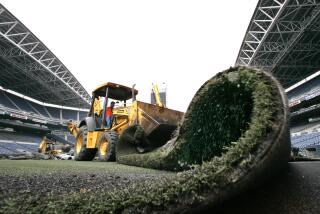L.A.âs wasteful sprinklers
Itâs raining. Itâs pouring. Or at least it was at 4 in the morning a couple of Saturdays ago. And though no old men were snoring in my vicinity, some sprinklers were watering lawns, rain or no rain. It was waste in its purest form because during and after a downpour the water runs right off the saturated soil into the street.
Turning curbs into waterfalls is a side effect of technology that lets us run sprinklers on timers that we set and forget. In theory, they allow watering at optimal but inconvenient times, such as early morning, when cooler air minimizes evaporation. In practice, timers mean homeowners have no idea what their sprinklers are doing because they donât see them sprinkling.
But if you walk your kids to school, or take a stroll after a losing battle with insomnia at 4 in the morning, you see the seamy underworld of urban lawn irrigation in all its profligate horror. Sprinklers run on the same schedule in December as in August, which means they use the maximum amount of water year round. They run too long, so water pools and cascades into the street. Sprinkler heads break and become geysers. Misaligned sprinklers water nothing but cars parked at the curb or pedestrians on the sidewalk, even if takes only fingers to realign them. (Yes, neighbors, I have sometimes braved the spray of your sprinklers and heroically set them back to rightness and truth. Youâre welcome).
Most sprinkler systems can be shut off with a switch labeled something like ârain off.â But someone has to actually do the switching, and itâs astonishing how many homeowners wonât bother or donât know how to operate their timers: they lose the manual or move into a house that already has a set timer system and never learn how it works. Or they leave their timers, like other maintenance, to gardeners who come once a week (and not at 4 in the morning).
Thereâs no way to tell exactly how much water badly timed or malfunctioning sprinklers actually waste. The Los Angeles Department of Water and Power isnât measuring runoff at 4 in the morning. But reasonable estimates of the wastage run between âstaggeringâ and âinsane.â
In 2007, The Times reported that sprinkler systems on municipal land alone wasted âmillions of gallonsâ through unnecessary timed watering and malfunctioning sprinklers but that upgrading irrigation systems was so expensive that it was cheaper for the cities to waste the water.
The Saving Water Partnership website of the Seattle and Participating Local Water Utilities says automatic sprinklers waste â40%-50% of the water used.â (Do they irrigate in Seattle? Has that place gone a week without rain since the last Ice Age?) The Mono Lake Committee â the Mono Basin is one of L.A.âs water sources â says improved sprinkler practices can save â750 to 1,500 gallonsâ a month.
If those estimates strike you as high, consider that if only 10,000 households each waste 100 gallons, thatâs 1 million wasted gallons. Thatâs probably a tiny fraction of what goes straight into Southern California streets. And weâre not even considering whether simply having a lawn, instead of drought-resistant plants, is an unacceptable waste of water and the huge amount of electricity it takes to pump it here.
I stopped using my sprinklers a couple of years ago. Watering by hand or using a soaker hose is not difficult, and the runoff can be measured in ounces. It does take time, but itâs time that can be spent multi-tasking: calling out-of-town friends and family during off-peak cellphone hours, for example, or working to master a facial expression of environmental moral superiority to display for neighbors and passersby.
Itâs OK with me if you continue to use your timed sprinklers (after all, I need to feel superior to someone), but at least use them competently. Look at them. See where the water is going, and when it goes there. We need to behave as if we understand that our water supply is perpetually in crisis.
Itâs 4 in the morning. Do you know what your sprinklers are doing?
Los Angeles attorney Howard Posner writes a column for California Lawyer magazine.
More to Read
A cure for the common opinion
Get thought-provoking perspectives with our weekly newsletter.
You may occasionally receive promotional content from the Los Angeles Times.










